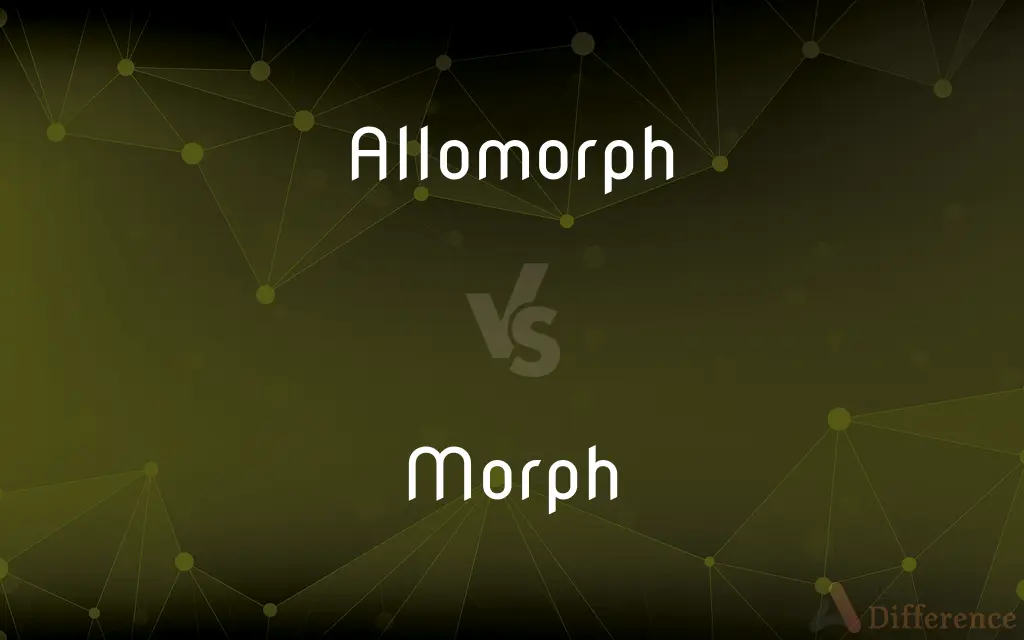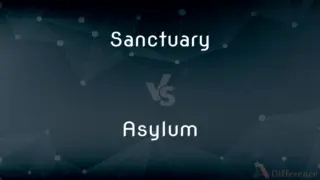Allomorph vs. Morph — What's the Difference?
Edited by Tayyaba Rehman — By Fiza Rafique — Updated on April 2, 2024
Allomorphs are variations of a morpheme, differing in sound but not in meaning, while a morph is any word component with meaning.

Difference Between Allomorph and Morph
Table of Contents
ADVERTISEMENT
Key Differences
Allomorphs refer to the variant forms a morpheme can take based on its phonological or morphological environment, illustrating the flexibility within language systems to convey the same semantic content through different phonetic expressions. For example, the plural morpheme in English can be realized as /s/, /z/, or /ɪz/, depending on the final sound of the noun it pluralizes. On the other hand, a morph is a more general term that represents the smallest grammatical unit in a language, capable of carrying meaning. This encompasses root words, prefixes, suffixes, and infixes, regardless of their variant forms.
While allomorphs are context-dependent and their appearance can change based on linguistic rules, morphs are the foundational building blocks of words and can be identified more straightforwardly. An allomorph's presence is only recognized in contrast to other variants of the same morpheme, suggesting a deeper layer of linguistic analysis where the sound changes but the meaning does not. In contrast, identifying a morph is a matter of recognizing its semantic or grammatical contribution to a word.
Allomorphs exemplify the concept of morphological variation within a language, indicating that the same morpheme can be represented in different ways without altering its inherent meaning. This phenomenon often arises from historical linguistic evolution and phonological constraints. Morphs, however, represent a broader category of linguistic elements, serving as the fundamental units through which words and their various forms are constructed and analyzed.
The study of allomorphs is crucial for understanding the nuances of morpheme behavior in different linguistic environments, highlighting how language adapts and varies its sounds while preserving semantic integrity. Conversely, the study of morphs is essential for grasping the basics of word formation and structure, providing insights into the building blocks of language without delving into the complexities of their variant forms.
Understanding the relationship between allomorphs and morphs sheds light on the dynamic nature of language, revealing how meaning can be preserved across different phonetic or morphological forms. This distinction is not just theoretical but has practical implications for language learning, linguistics research, and the development of natural language processing technologies.
ADVERTISEMENT
Comparison Chart
Definition
Variant form of a morpheme
The smallest grammatical unit with meaning
Role in Language
Represents phonological or morphological variations of a morpheme
Fundamental building blocks of words
Variation
Changes based on linguistic context
Stable across contexts
Recognition
Identified by contrasting with other variants of the same morpheme
Identified by semantic or grammatical contribution
Contribution to Word Formation
Highlights flexibility and adaptation in language
Basis for constructing words and their forms
Compare with Definitions
Allomorph
A variant form of a morpheme that does not alter the morpheme's meaning.
The -s, -es, and -ies suffixes are allomorphs for forming plurals in English.
Morph
The smallest unit of language that carries meaning.
The word cats contains two morphs: cat + plural suffix -s.
Allomorph
An alternative manifestation of a morpheme in different linguistic environments.
The past tense morpheme in walked vs. drove.
Morph
Any prefix, suffix, infix, or root that can be identified as adding meaning to a word.
Un- in unhappy negates the meaning of happy.
Allomorph
The form a morpheme takes based on specific linguistic rules.
The use of a or an in English depending on the following word's initial sound.
Morph
A linguistic element that is identifiable as a discrete unit of meaning within a word.
The er in teacher signifies one who performs the action of teaching.
Allomorph
A morpheme variant that is determined by morphological or phonological conditions.
The allomorphs of the negative prefix in English: in-, im-, il-, ir-.
Morph
A component of a word that contributes to its meaning.
In reopened, re- and ed are morphs indicating repetition and past tense, respectively.
Allomorph
The occurrence of different phonetic realizations that carry the same grammatical function.
The indefinite article a becomes an before a vowel sound.
Morph
The elemental units that contribute to word formation and syntax.
Anti- in antibacterial contributes the meaning of opposition.
Allomorph
In linguistics, an allomorph is a variant phonetic form of a morpheme, or, a unit of meaning that varies in sound and spelling without changing the meaning. The term allomorph describes the realization of phonological variations for a specific morpheme.
Morph
An allomorph.
Allomorph
See paramorph.
Morph
One of various distinct forms of a species (such as color variant) or of an organism during different parts of its life cycle.
Allomorph
Any of the variant forms of a morpheme. For example, the phonetic (s) of cats (kăts), (z) of pigs (pĭgz), and (ĭz) horses (hôrsĭz) are allomorphs of the English plural morpheme.
Morph
To transform (an image) by computer
Cinematic special effects that morphed the villain into a snake.
Allomorph
(chemistry) Any of the different crystalline forms of a substance.
Morph
To be transformed
"By morning all his hurt feelings had morphed into mischief" (Dana Adam Shapiro).
Allomorph
(linguistics) Any of the different phonological representations of a morpheme.
Morph
A recurrent distinctive sound or sequence of sounds representing an indivisible morphological form; especially as representing a morpheme.
Allomorph
Any one of two or more distinct crystalline forms of the same substance; or the substance having such forms; - as, carbonate of lime occurs in the allomorphs calcite and aragonite.
Morph
(linguistics) An allomorph: one of a set of realizations that a morpheme can have in different contexts.
Allomorph
Any of several different crystalline forms of the same chemical compound;
Calcium carbonate occurs in the allomorphs calcite and aragonite
Morph
(zoology) A variety of a species, distinguishable from other individuals of the species by morphology or behaviour.
Allomorph
A variant phonological representation of a morpheme;
The final sounds of `bets' and `beds' and `horses' and `oxen' are allomorphs of the English plural morpheme
Morph
A computer-generated gradual change from one image to another.
Morph
(slang) morphine
Morph
To change shape, from one form to another, through computer animation.
Morph
To shapeshift.
Morph
(by extension) To undergo dramatic change in a seamless and barely noticeable fashion.
Morph
A sequence of phonemes, often a word fragment, which constitutes the minimum unit of meaning or syntax within a given word. A morph may be one of several variants of a morpheme, depending for its individal form on the context in which it occurs. Thus the morphs -s and -es are variants of the morpheme by which the plural form of an English noun is expressed.
Morph
To transform smoothly in imperceptible steps from one image to another, on a computer screen.
Morph
Cause to change shape in a computer animation;
The computer programmer morphed the image
Morph
Change shape as via computer animation;
In the video, Michael Jackson morphed into a panther
Common Curiosities
Can a single word contain multiple morphs?
Yes, a single word can contain multiple morphs, including a root and one or more affixes (prefixes, suffixes).
How do allomorphs differ from morphs?
Allomorphs are variations of a specific morpheme that differ in form but not meaning, while morphs are the basic meaningful units that can constitute parts of a word.
What is a morph?
A morph is the smallest grammatical unit in a language that can carry meaning, such as root words, prefixes, and suffixes.
Why are allomorphs important in linguistics?
Allomorphs are important because they illustrate how morphemes can vary in form without altering their meaning, offering insights into language flexibility and phonological rules.
Can the concept of morphs be applied to all languages?
Yes, the concept of morphs is applicable to all languages, as all languages have meaningful units that make up words and expressions.
What is an allomorph?
An allomorph is a variant form of a morpheme that appears differently depending on the linguistic environment but does not change the morpheme's meaning.
What is an example of a morph?
An example of a morph is the suffix "-ed," which is added to verbs to indicate the past tense.
What role do morphs play in language?
Morphs are foundational to the structure of words, playing a crucial role in word formation, meaning, and grammatical function.
Can allomorphs change the meaning of a morpheme?
No, allomorphs do not change the meaning of a morpheme; they only represent different phonetic or morphological expressions of the same morpheme.
How do linguists study allomorphs?
Linguists study allomorphs by examining the conditions under which morphemes change form in different linguistic environments, using tools from phonology and morphology.
How are allomorphs identified?
Allomorphs are identified by analyzing how a morpheme's form varies in different phonological or morphological contexts without altering its inherent meaning.
Do all morphemes have allomorphs?
Not all morphemes have allomorphs; some morphemes appear in a single form regardless of the linguistic context.
How does understanding morphs help in learning a language?
Understanding morphs helps in learning a language by providing insights into word structure, meaning, and the construction of grammatical forms.
What is the difference between a free morph and an allomorph?
A free morph can stand alone as a word, while an allomorph refers specifically to variant forms of a morpheme, not its ability to stand alone.
Are allomorphs specific to certain languages?
The concept of allomorphs applies to many languages, but the specific allomorphs and the conditions under which they appear can vary widely between languages.
Share Your Discovery

Previous Comparison
Sanctuary vs. Asylum
Next Comparison
Miniskirt vs. MicroskirtAuthor Spotlight
Written by
Fiza RafiqueFiza Rafique is a skilled content writer at AskDifference.com, where she meticulously refines and enhances written pieces. Drawing from her vast editorial expertise, Fiza ensures clarity, accuracy, and precision in every article. Passionate about language, she continually seeks to elevate the quality of content for readers worldwide.
Edited by
Tayyaba RehmanTayyaba Rehman is a distinguished writer, currently serving as a primary contributor to askdifference.com. As a researcher in semantics and etymology, Tayyaba's passion for the complexity of languages and their distinctions has found a perfect home on the platform. Tayyaba delves into the intricacies of language, distinguishing between commonly confused words and phrases, thereby providing clarity for readers worldwide.














































